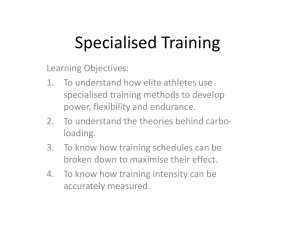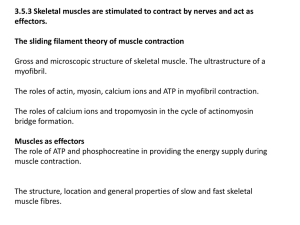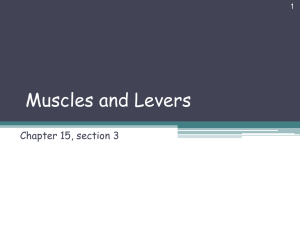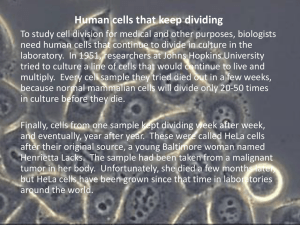Plyometrics
advertisement
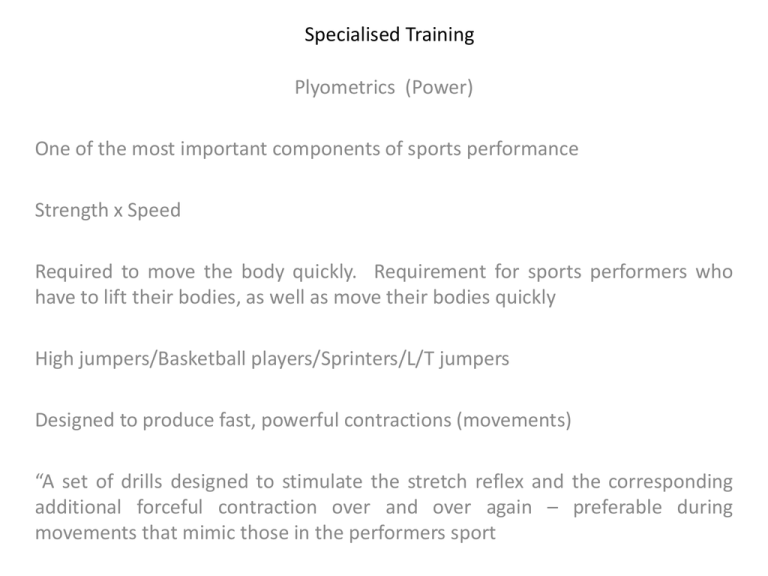
Specialised Training Plyometrics (Power) One of the most important components of sports performance Strength x Speed Required to move the body quickly. Requirement for sports performers who have to lift their bodies, as well as move their bodies quickly High jumpers/Basketball players/Sprinters/L/T jumpers Designed to produce fast, powerful contractions (movements) “A set of drills designed to stimulate the stretch reflex and the corresponding additional forceful contraction over and over again – preferable during movements that mimic those in the performers sport • Stretch Reflex How does Plyometrics work? • Performance of high Intensity, explosive muscular contractions that engage the Stretch-Reflex. • What is the Stretch Reflex? A protective mechanism that prohibits overstretching of muscle fibres The action of stretching the muscle before it contracts……so that it contracts with greater force. Any movement that may overstretch the muscle fibre is detected by specialist receptors – muscle spindles When the muscle spindles are activated, a nerve impulse is sent to the spinal cord. This results in the immediate contraction of the muscle being overstretched. Plyometrics and Contractions • Eccentric contractions occur when the muscle lengthens as it develops tension • These contractions occur during DOWNWARD movements – as the muscle controls descent against the force of gravity • When muscles shorten during contraction, this involves Concentric Contractions – which occur during upward movement • ECCENTRIC = Lengthen CONCENTRIC = Shorten • A plyometric contraction involves an initial rapid eccentric movement, followed by an explosive concentric contraction Example of Plyometric movement • A muscle that is eccentrically stretched before a concentric contraction will contract more forcefully and more rapidly. • The SQUAT: Prior to performing a vertical jump – you perform a deep squat. When you lower the body quickly, the muscles involved in the jump are momentarily stretched – producing a more powerful movement The Stretch reflex increases the activity in the muscle undergoing the (eccentric muscle action), allowing to act much more forcefully The result is a powerful braking effect, with the potential for a powerful concentric muscle action. If the concentric contraction muscle action does not occur immediately after the pre-stretch, the potential energy produced, will be lost How Plyometric Exercises Work A muscle that is stretched before a concentric contraction, will contract more forcefully and more rapidly (4,5). A classic example is a dip" just prior to a vertical jump. By lowering the center of gravity quickly, the muscles involved in the jump are momentarily stretched producing a more powerful movement. But why does this occur? Two models have been proposed to explain this phenomenon. The first is the Mechanical Model In this model, elastic energy is created in the muscles and tendons and stored as a result of a rapid stretch (6,7,8). This stored energy is then released when the stretch is followed immediately by a concentric muscle action. According to Hill (9) the effect is like that of stretching a spring, which wants to return to its natural length. The spring is this case a component of the muscles and tendons called the series elastic component. The second model is the Neurophysical Model When a quick stretch is detected in the muscles, an involuntary, protective response occurs to prevent overstretching and injury. This response is known as the stretch reflex. The stretch reflex increases the activity in the muscles undergoing the stretch or eccentric muscle action, allowing it to act much more forcefully. The result is a powerful braking effect and the potential for a powerful concentric muscle action (10,11,12). If the concentric muscle action does not occur immediately after the pre-stretch, the potential energy produced by the stretch reflex response is lost. (i.e. if there is a delay between dipping down and then jumping up, the effect of the counter-dip is lost). It is thought that both the mechanical model (series elastic component) and the neurophysical model (stretch reflex) increase the rate of force production during plyometrics exercises (6,7,8,10,11,12). • The Stretch-Shortening Cycle • All plyometric movements involve three phases. The first phase is the pre-stretch or eccentric muscle action. Here, elastic energy is generated and stored. • The second phase is the time between the end of the pre-stretch and the start of the concentric muscle action. This brief transition period from stretching to contracting is known as the amortization phase. The shorter this phase is, the more powerful the subsequent muscle contraction will be. • The third and final phase is the actual muscle contraction. In practice, this is the movement the athlete desires the powerful jump or throw. • This sequence of three phases is called the stretch-shortening cycle. In fact, plyometrics could also be called stretch-shortening cycle exercises (1). • Plyometric push up training • Plyometric training • Students performing Plyometric exercises PNF Stretching • Static – muscle stretched to a point of resistance – then held • Dynamic/Ballistic – repetitive bouncing/rebounding or rhythmic motions • PNF – Proprioceptive Neuromuscular Facilitation – alternating contraction and relaxation movements • PNF can be performed Actively (voluntary muscle contraction) and Passively (no associated muscle movement) • PNF – facilitates the body’s muscle inhibition • Many styles of PNF are practiced today, the most popular one being the ‘CRAC’ technique PNF - Cont • Contract – Relax, Antagonist - Contract • How does it work? Isometric muscle contractions completed immediately before a passive stretch, help to achieve autogentic inhibition. Which is…? When the muscles gradually relax. Muscle spindles located within a muscle cells, protect a muscle from injury. Muscle spindles sense HOW FAR and HOW FAST a muscle is being stretched and when activated, produce the STRETCH REFLEX. This causes the muscle to contract and prevents overstretching of the joint. Practical Example Take the stretch to the limit of your ROM ….. Your leg starts to jump/twitch Muscle spindles have been activated Telling muscle to contract to prevent any further stretching Golgi Tendon Organ (GTO) Also located within the muscle’s tendon is another sensor Senses how much TENSION is being placed on the tendon How does the GTO differ from the muscle spindle? When activated the GTO RELAXES the muscle Autogenic inhibition is reflex relaxation that occurs in the same muscle where the GTO is stimulated The Isometric contraction referred to as ‘HOLD’ The Concentric contraction is referred to as ‘CONTRACT’ Glycogen Loading • Glycogen is the predominant energy source - events longer than 1hr • Fat can be used during similar events, but fat generally supports a lower intensity of exercise. Can you remember why? Fat uses more Oxygen to resynthesise ATP. Therefore speed drops when fat becomes the main provider of energy for ATP resynthesis • Unlike fat, glycogen stores in the body are limited. • Glycogen in your muscles is rapidly depleted during fairly intense exercise • Muscles begin to suffer shortage of glycogen after 60-90 min – after this, athletes will then have to rely on the slower fat metabolism • “Hitting the Wall” - transition from glycogen-based metabolism switches to fat-based system Glycogen Loading • Athletes need to ‘boost’ their muscle glycogen stores to more than normal, so they DO NOT have to resort to fat metabolism for ATP resynthesis during their event. • “Supercompensation” – Allowing body to store more glycogen than normal • • • • However process leaves athletes: heavy-legged – due to the intensive training prior to glycogen loading Bloating – glycogen storage involves storage of water Lethargic – due to extra glycogen • Athletes generally hard training, but increase their carb intake as a method of glycogen loading • A combination of tapering training and an increase of carbohydrates will lead to a higher level of glycogen being stored. • 6-8g of carbs per kg of body weight mass is sufficient to permit glycogen loading. • Endurance athletes however, follow a reduced carb diet to maintain low body weight, so the increase is often too much. • Carb loading does not work for everyone, and can sometimes work or not • Eg of High Carb Diet New method • Very high intensities of exercise – stimulate higher rates of muscle glycogen storage, rather than prolonged moderate intensities • 3 min burst of intense exercise, followed by a 24hr high carb eating regime – literally beginning within 20 mins after the exercise • Consuming 9g per kg of body weight • What does this do? • Opens the ‘carb window’ in the muscles when glycogen stores can be increased dramatically. The ‘window’ appears to ‘close’ within 2hrs Marathon Runner • Follow normal diet during week prior to race • Therefore…..no bloating, lethargy, heaviness, gastric discomfort • Training is tapered during whole week anyway • Day before race – athlete warms up, work hard for 3 mins • Stop – begin consuming large quantities of carbohydrates throughout the next 24 hrs. Little and often. 6-7 meals, rather than increasing usual 3 meals. • Race day – they should feel great and have extra glycogen in their legs June 2010 • • Question 1 At the 2008 Beijing Olympic Games, David Davies won the silver medal in the swimming 10 km marathon event, in a time of 1 hour 51 minutes and 53.1 seconds. • 0 1 Explain how the majority of energy used during the race would be provided and outline the process of ‘glycogen loading’ that may be used by performers to improve performance in this type of event. (14 marks) • June 2010 Mark Scheme Specimen Paper • • Question 11 ‘Sport performers should be allowed to use performance enhancing drugs like any other training aid.’ • 1 8 Discuss this statement. (7 marks) • • • • • • • • • • • • • • • • • Yes: sub max 4 marks 1. Battle against drugs is expensive/time consuming 2. Detection not effective/always behind chemists 3. Difficult to define drug as compared to aid/supplement 4. Sacrifices performer makes to achieve success is personal 5. High performance leads to more spectators/sponsors/money 6. Level playing field for all No: sub max 4 marks 7. Side effects are dangerous/health risks 8. Young tempted to use them/role model effect 9. Coaches/peer pressure may force performers to use drugs 10. Sport is about using natural talent 11. Drug use is outside this concept 12. Cheating/unethical 13. Costly 14. Only the richer countries will be able to afford the technology, therefore uneven playing field Periodisation • Eg of Periodisation • The organisation of training throughout the season – so that optimal physiological/psychological peak can be reached. • If you want to progress to a higher level of difficulty, you have to apply the principle of Progression. As long as you do not exceed your body’s ability to adapt – you will steadily get better • As an athlete, you are aiming for ‘Performance gains’, as well as ensuring that you reach your full potential • However, you training must be ‘Goal orientated’ as well to reach your full potential • In order to optimise performance, training must be quite specific, it is NOT just a case of adjusting workload The Endurance Athlete • Increase VO2 Max • Increase Lactate Threshold • Increase strength of muscles/connective tissue • Directly increases Power • Developing technique = increases efficiency • Preserve energy • Periodisation ensures that you approach your training step by step, rather than attempting to improve everything at once. • In summary: Periodisation allows you to divide your training programme into parts/periods/phases – designed to achieve different goals • Jessica Ennis • Training programmes should be divided into units called CYCLES: MACRO/MESO/MICRO MACROCYCLE • Long stretch of training, intended to accomplish a significant, overall goal. Eg: Preparation for and completion of an important competition • Made up of a number of different mesocycles – covering a period of many months • Can last for up to 10 months. • Macrocycles do not really change from one year to the next. 1 year is generally the largest unit of periodisation • ‘Large’ macrocycles can be used, consisting of 2-4 ‘small’ macrocycles lasting about a year. The smaller macrocycles can vary considerably Eg: High Jumper Long Term Goal/Plan (MACROCYCLE): Competing in 2012 London Games: First ‘small’ macrocycle: Majority of 2010 working on Agility, Flexibility, Strength and Power (Very little time devoted to jumping or competition) Second ‘small’ macrocycle: In 2011, greater emphasis on technique, with an increase in competition Overall ‘large’ macrocycle: 32 month period from beginning of 2010 to the London Olympic Games MESOCYCLE • Block of training, consisting of a number of microcycles (repeating group/pattern of training sessions) • Highlights the achieving/reaching of a particular goal. Eg: • Shot-putter – time taken concentrating on their overall strength training as a prelude to working on another mesocycle, that would emphasise improving their speed across the circle • Rugby Player – Several weeks spent on their line-out techniques • Macrocycle is made up of a number of different mesocycles (4-12 wks), covering a period of many months Microcycle • Mircocycle lasts for 5-10 days • A number of training sessions, which form a repeating unit. • Hard/Easy/Rest/Hard/Easy/Rest – this represents a basic training unit – the microcycle • Rugby Player – Weights/Interval/Squad/Rest/Match – repetitive weekly pattern = MIRCOCYCLE Once you have planned your training schedule, it is important to follow the necessary pre-competition preparation in order to benefit from all your training Tapering/Peaking • Through planning a training schedule, athletes attempt to maintain their high levels of fitness throughout the competition period. • But, due to prior training and involvement in competition, they must also ensure they avoid “OVERTRAINING” • “The physical and mental state that is due to excessive training without adequate recovery” • This can be achieved by attending less competitions and ensuring they perform at their best in the big competition • In order for athletes to be in an ‘optimal state of readiness’ for a competition, they will begin reducing their daily training loads for a few days before the big event • “TAPERING” – reducing the amount of training and/or the training intensity prior to competition day. • As well as athletes being physically prepared for competition, they must also ensure their mental preparation is, as well rehearsed. • Being physically and mentally prepared for the ‘rigours’ of the big competition is called ‘PEAKING’ Thermoregulation in differing environments • Heat from exercise is a waste product generated by muscular contraction • Homeothermic – keep internal body temp constant = Humans • However, during exercise, it is necessary to lose heat to keep body temp constant. • In order for heat to be lost from the body, it must have access to the outside. Blood is moved from the core of the body, to close to the surface of the skin. • Heat can then be lost to the surrounding environment by any 4 mechanisms: 4 Mechanisms for Heat Loss • Conduction: Transfer of heat through direct contact – from warm skin to clothes/air • Convection: Transfer of heat by gases. Air passing over our skin takes away air molecules that have been warmed by the skin • Radiation: Body loses about 60% of its heat through radiating infrared rays to its surroundings, because the surroundings are cooler than your body • Evaporation: Main way we lose heat during exercise. As fluid evaporates from the skin, heat is lost Internal body temp ↑, produce more sweat – evaporates – losing heat from body 2 ways of controlling Internal Body Temp • Thermoregulatory centre in the Hypothalamus of the brain • Changes in body temp are detected by receptors, with the info being sent to the Hypothalamus. • This starts mechanisms such as sweating, to cool the body (1st) • Under the control of the hypothalamus, the rings of smooth muscle around arterioles are able to dilate, which increases blood flow to the skin • Warm blood from the body’s core dissipates its heat by C/C/R • In cold conditions it is necessary to generate heat – shivering – a rapid involuntary cycle of contraction and relaxation of the skeletal muscle (2nd) The Blood • 2 main functions during exercise: • Supply muscles with the nutrients and oxygen they require • Supply the skin to allow heat to be lost. • During exercise in a warm environment, a large proportion of the cardiac output must be shared by the skin and the working muscles • When exercising, there is a redistribution of blood with extra being supplied to the skin and muscles. • This in turn reduces the volume of blood returning to the heart – reducing stroke volume The Heart • In order to maintain the cardiac output required, there has to be a gradual increase in HR: “Cardiovascular Drift” • The combination of a high rate of heat production from the exercise AND a restricted capacity for heat loss can lead to: ‘Hyperthermia’ “A condition in which body temp is elevated to a very high level” • This will inevitably impair performance: • VO2 max is significantly reduced • HR increases (meet need to ↑ blood flow to skin for cooling and maintain O2 supply to working muscles) • Internal temp is raised • HR rises in an attempt to meet the needs Exercise in Extreme Conditions • The body can acclimatise to environmental conditions – several weeks of training in high temps/humidity improves efficiency of body in removing excess heat. • • • • In cold conditions: Body attempts to gain heat by shivering Vasoconstriction of arterioles near skin’s surface Heat loss increased by wind increases Convection (wind chill) • Reduction of muscular strength • Energy supplies quickly reduced less force more lactate ex intensity declines Hypothermia (below 35c) Lactate Sampling • Elite athletes are capable of training at intensities close to their VO2 Max Close to the point of exhaustion • Training needs to be beneficial – without being so intense to cause long lasting damage • Lactate sampling involves taking a minute sample of blood, within seconds, the hand-held machine analyses the sample and produces a figure representing the amount of lactate present • Lactate threshold is usually taken to be a 2mmol increase in lactate per litre of blood above resting levels. • Lactate threshold can also be referred to as OBLA (although OBLA is taken to be a level of 4mmol of lactate per litre of blood • If lactate levels rise during training, it is because anaerobic glycolysis is occurring in the exercising muscles. • This is now becoming the main method of resynthesising ATP • When training athletes need to train at Oxygen consumption/Intensity levels above their lactate threshold. • Higher levels of lactate = indication of a higher intensity of workout being taken • Lactate Threshold is linked to VO2 max: • The higher the % of VO2 Max/higher the pace at which lactate threshold occurs = the fitter the athlete • Testing used in cycling/rowing/swimming Respiratory Exchange Ratio (RER) • Ratio of CO2 released by the body, to the volume of oxygen consumed • It can be used to estimate relative contributions of Fat and Carbohydrate to the provision of energy for ATP resynthesis • RER is an indicator of fat \and carbohydrate breakdown – BECAUSE: • Fat and Carbohydrate differ in terms of the amount of oxygen used/carbon dioxide produced during oxidation • REMEMBER: Fat oxidation requires much more oxygen than carbohydrate metabolism When FAT is the major fuel, amount of oxygen being consumed will tend to be a big number – VCO2/VO2 AND RER a small number • Measurement of VCO2/VO2 is taken using a cycle ergometer/treadmill. • Athlete is attached to a gas analyser, so the volumes of CO2 being produced and oxygen being consumed are measured directly


